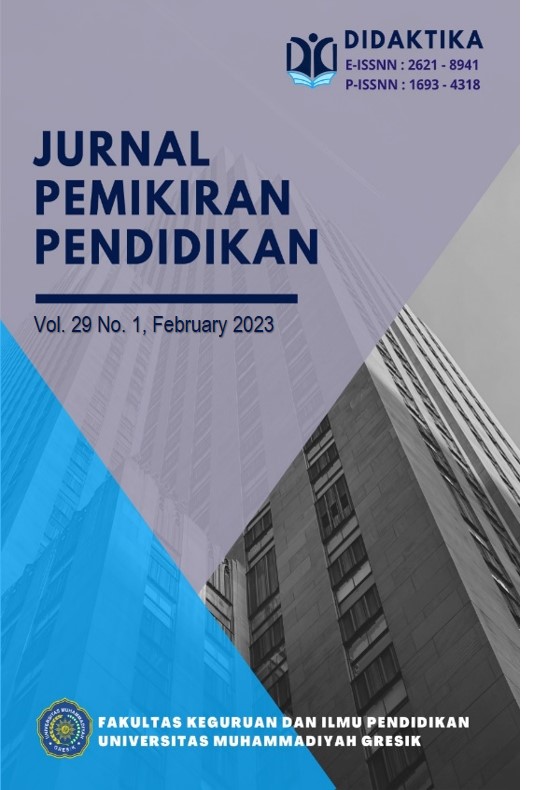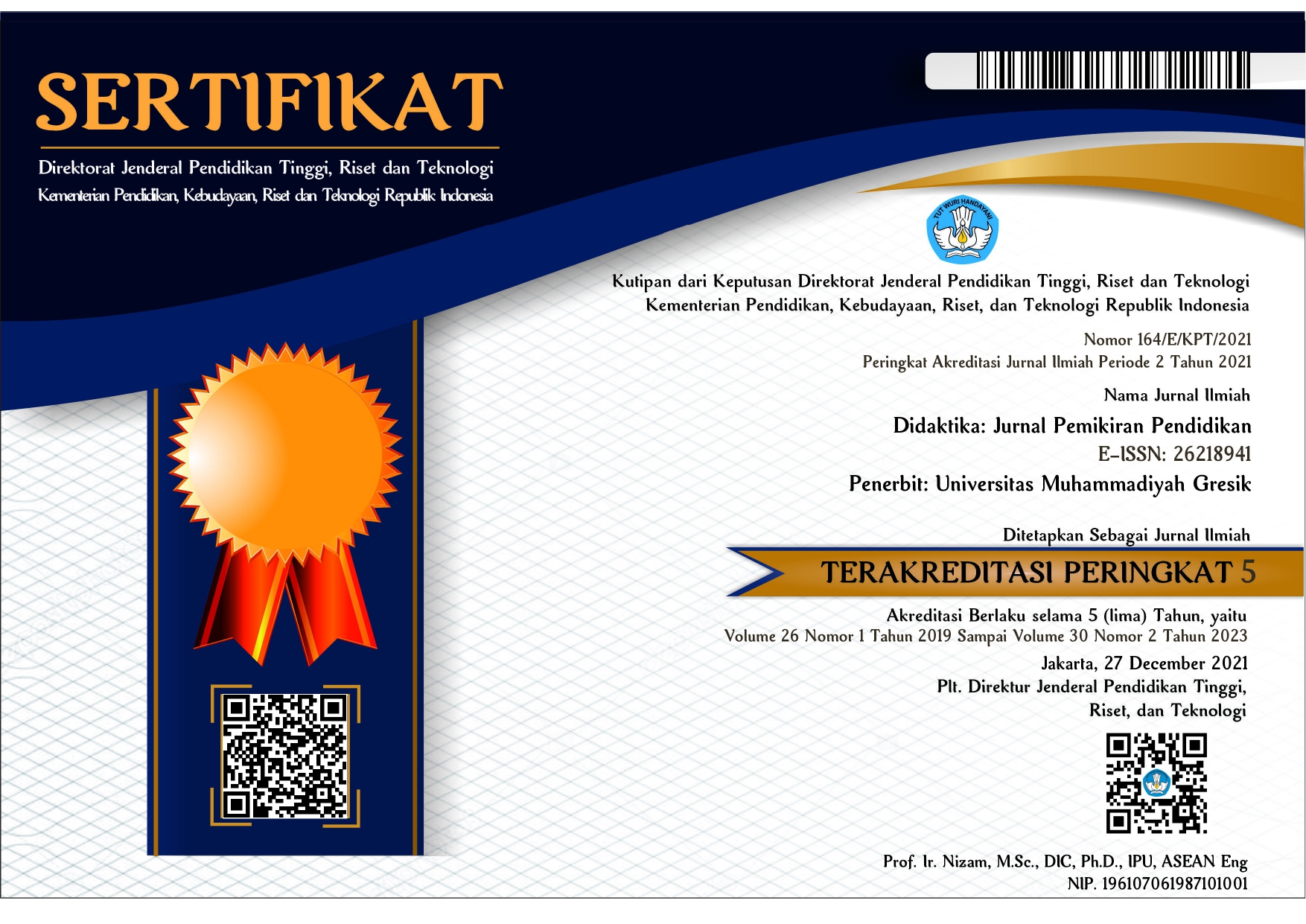The Effect of Online Pictures on English Proficiency and Classroom Interaction at Junior High School of Ban Kaengsriphoom Loei Thailand
DOI:
https://doi.org/10.30587/didaktika.v29i1.5247Keywords:
Online Picture, English Proficiency, Classroom InteractionAbstract
This study aims to determine the use of online pictures for English and interaction in class among junior high school students at Ban Kaengsriphoom School, Loei Thailand. This research uses ex-post facto, with a sample of 81 students who are a combination of grades VII, VIII and IX. Data collection was used on the results of student scores of the midterm and finalfinal exams test of semester one and questionnaires. Data analysis used pre-test and post-test scores (Paired Sample T-Test). The results of this study are: (1) there was an average increase in each group, for class VII (pre-test = 16.00 to post-test = 19.55), class VIII (pre-test = 16.24 to post-test = 23.20), class IX (pre-test = 14.71 to post-test = 19.19); (2) The average from the pre-test and post-test has a Sig. Value 0.000 is less than 0.05 (0.000 < 0.05); (3) The response from the questionnaire has an average of 4.64. It concludes that the online picture as an online media can increase student English proficiency because learning runs easily. So, students feel helpful to interact with teachers or other friends.
References
Asrifan, A. (2021). Code-Mixing and Code-Switching in the Efl Classroom Interaction. 1–31.
Aziz, M. S. A. (2021). Online Picture-Guided Worksheet To Improve the First Conditional Sentence Writing: a Classroom Action Research. English Language Teaching, Literature, and …, 1937. Retrieved from https://proceeding.unnes.ac.id/index.php/eltlt2021/article/view/1315%0Ahttps://proceeding.unnes.ac.id/index.php/eltlt2021/article/download/1315/832
Deviga, Lidia, R. A. A. (n.d.). Journal of Linguistics and English Teaching Studies. 14–22. Retrieved from https://jurnal.stainmajene.ac.id/index.php/lets/article/view/91
Deviga, L., & Diliyana, Y. F. (2020). Using Picture Series in Teaching Writing Skill for The First Semester Students of Medical Record Program in Stikes Bhakti Husada Mulia Madiun. English Teaching Journal: A Journal of English Literature, Linguistics, and Education, 8(2), 75–81. https://doi.org/10.25273/etj.v8i2.7827
Gill, D. (2005). Meeting Differing Learning Styles Of Non-traditional Students In The Second Language Classroom. Journal of College Teaching & Learning (TLC), 2(8), 1–8. https://doi.org/10.19030/tlc.v2i8.1848
Girsang, E. R. (2021). Improving Students’ Narrative Writing Ability by Implementing Digital Picture Series in Online EFL Class. Journal of Research on English Language Teaching in Indonesia (RETAIN), 9(3), 117–123.
Hanum, N. S. (2009). The Importance of Classroom Interaction in the Teaching of Reading in Junior High School. Core, 2(1), 1–9.
Marhaeni, S., Syamsuri, A. S., & Arif, T. A. (2020). Pengaruh Penggunaan Metode Konvensional Berbantuan Media Gambar Terhadap Kemampuan Berbicara Siswa Kelas IV Sekolah Dasar Di Kota Makassar. Syntax Literate : Jurnal Ilmiah Indonesia, 5(6), 192–201. Retrieved from http://www.jurnal.syntaxliterate.co.id/index.php/syntax-literate/article/view/1334
Nina Sundari. (2019). Penggunaan Media Gambar Dalam Meningkatkan Keaktifan Siswa Dalam Pembelajaran Pengetahuan Sosial. Angewandte Chemie International Edition, 6(11), 951–952., 5(1), 9–25.
Purba, E., Saragih, A., & Ginting, S. A. (2018). Classroom Interaction in English Lesson Based on Flander’S Interaction Categories (Fiac). GENRE Journal of Applied Linguistics of FBS Unimed, 6(1). https://doi.org/10.24114/genre.v6i1.8495
Rahmah, W. M., & Rahayu, E. M. (2022). Students’Perceptions of Using Picture Storybook in Teaching Vocabulary At Junior High School in the Pandemic Era. … and Language Teaching, (InCoLLT), 283–289. Retrieved from https://incollt.unipasby.ac.id/proceedings/index.php/incollt/article/view/34%0Ahttps://incollt.unipasby.ac.id/proceedings/index.php/incollt/article/download/34/29
Safitri, N. E., & Yogyakarta, U. N. (n.d.). THE EFFECTS OF PARENT INTERACTION ’ S INTENSITY AND PEER FRIENDS. 695–704.
Selan, F. N. (2022). A STUDY ON USING PICTURE TO MOTIVATE STUDENTS IN LEARNING ENGLISH OF THE FIRST GRADE STUDENTS OF SMA DHARMA AYU. 5(1), 21–26.
Tiwery, D. S., & Souisa, T. R. (2019). Inside-outside circle as the way in building students’ motivation and interaction in speaking classroom activities. International Journal of Language Education, 3(1), 33–45. https://doi.org/10.26858/ijole.v1i1.6703
Watson, J. (2005). Keeping Pace with K-12 Online Learning 2005. Learning Point Associates/North Central Regional Educational Laboratory (NCREL), 131. Retrieved from http://eric.ed.gov/PDFS/ED489514.pdf
Winita, R. A., & Rasyida, F. S. (2018). Teaching English Vocabulary Using Picture in Eighth Grade of Junior High School. PROJECT (Professional Journal of English Education), 1(3), 169. https://doi.org/10.22460/project.v1i3.p169-174
Downloads
Published
How to Cite
Issue
Section
License
License and Copyright Agreement
In submitting the manuscript to the journal, the authors certify that:
- They are authorized by their co-authors to enter into these arrangements.
- The work described has not been formally published before, except in the form of an abstract or as part of a published lecture, review, thesis, or overlay journal.
- That it is not under consideration for publication elsewhere,
- That its publication has been approved by all the author(s) and by the responsible authorities – tacitly or explicitly – of the institutes where the work has been carried out.
- They secure the right to reproduce any material that has already been published or copyrighted elsewhere.
- They agree to the following license and copyright agreement.
Copyright
Authors who publish with DIDAKTIKA: Jurnal Pemikiran Pendidikan agree to the following terms:
- Authors retain copyright and grant the journal right of first publication with the work simultaneously licensed under a Creative Commons Attribution License (CC BY-SA 4.0) that allows others to share the work with an acknowledgment of the work's authorship and initial publication in this journal.
- Authors are able to enter into separate, additional contractual arrangements for the non-exclusive distribution of the journal's published version of the work (e.g., post it to an institutional repository or publish it in a book), with an acknowledgment of its initial publication in this journal.
- Authors are permitted and encouraged to post their work online (e.g., in institutional repositories or on their website) prior to and during the submission process, as it can lead to productive exchanges, as well as earlier and greater citation of published work.
Licensing for Data Publication
Open Data and Software Publishing and Sharing
The journal strives to maximize the replicability of the research published in it. Authors are thus required to share all data, code or protocols underlying the research reported in their articles. Exceptions are permitted but have to be justified in a written public statement accompanying the article.
Datasets and software should be deposited and permanently archived inappropriate, trusted, general, or domain-specific repositories (please consult http://service.re3data.org and/or software repositories such as GitHub, GitLab, Bioinformatics.org, or equivalent). The associated persistent identifiers (e.g. DOI, or others) of the dataset(s) must be included in the data or software resources section of the article. Reference(s) to datasets and software should also be included in the reference list of the article with DOIs (where available). Where no domain-specific data repository exists, authors should deposit their datasets in a general repository such as ZENODO, Dryad, Dataverse, or others.
Small data may also be published as data files or packages supplementary to a research article, however, the authors should prefer in all cases a deposition in data repositories.











